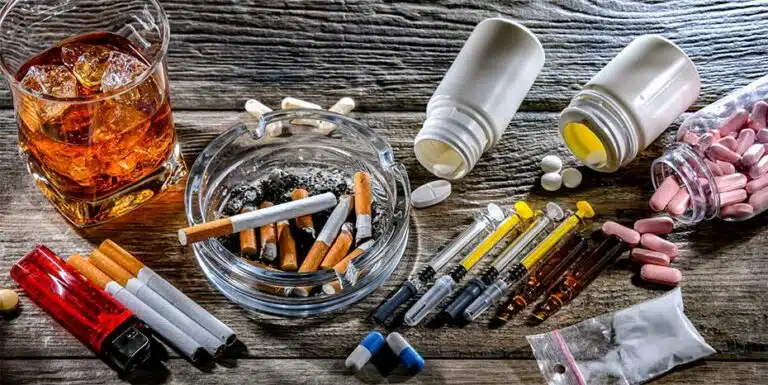The Top 5 Most Deadly Drug Combinations

In 2019, nearly half of all drug overdose deaths involved polysubstance abuse. Polysubstance abuse occurs when you combine multiple drugs at once, usually to achieve a more intense high.
Some drug combinations pose greater risks than others. Here are five of the most dangerous.
1. Opioids & Alcohol
Opioids (also called opiates) are a class of drugs that reduce pain. They include prescription painkillers like oxycodone (OxyContin) and hydrocodone (Vicodin), as well as the illicit drug heroin.
Along with pain relief, opioids can also cause euphoria (intense joy). To enhance euphoria, some people mix opioids with alcohol.
This practice is highly dangerous. That’s because both opioids and alcohol are central nervous system (CNS) depressants, which means they slow down your brain activity, breathing, and heart rate.
If you mix them, your central nervous system may slow to the point of a life-threatening overdose.
Opioid & Alcohol Overdose
Common symptoms of an overdose involving opioids and alcohol include:
- drowsiness
- dizziness
- slurred speech
- nausea and vomiting
- changes in blood pressure
- slow or irregular heartbeat
- respiratory depression (slow, ineffective breathing)
- loss of consciousness
2. Benzodiazepines & Alcohol
Benzodiazepines (also called “benzos”) are prescription medications that can help treat anxiety, seizures, and insomnia (trouble sleeping). Popular examples include alprazolam (Xanax), clonazepam (Klonopin), and lorazepam (Ativan).
Like alcohol, benzodiazepines can make you feel relaxed and happy. That’s why some people take them while drinking.
Unfortunately, also like alcohol, benzodiazepines slow down your central nervous system. Thus, mixing these substances can slow your breathing and heart rate to a fatal degree.
Intensified Side Effects
In addition, alcohol can intensify the side effects of benzodiazepines. The most common side effects include:
- dry mouth
- headache
- drowsiness
- dizziness
- confusion
- muscle weakness
- trouble urinating or more frequent urination
- changes in sex drive or ability
More severe side effects include loss of control of bodily movements and uncontrollable shaking of a part of the body.
3. Heroin & Cocaine
As two of the most popular illegal drugs, heroin and cocaine act in very different ways.
Heroin slows down your central nervous system, making you feel relaxed and sleepy. Cocaine speeds up your central nervous system, making you feel energized and alert. Some people think that mixing the two (also known as “speedballing”) will cancel out their negative effects.
SpeedBalling
Indeed, cocaine might make you feel less drowsy than you would if you used heroin by itself. However, it won’t stop heroin from slowing down your breathing and heart to a life-threatening degree.
That means you could die of a heroin overdose even if you don’t feel the drug’s effects as intensely as you might expect.
In fact, some people who speedball assume that the lack of drowsiness means they have not taken enough heroin. They then take even more heroin, accelerating their risk of overdose.
4. Cocaine & Alcohol
When combined, cocaine and alcohol create a toxic compound known as cocaethylene. Cocaethylene takes a serious toll on your liver and cardiovascular system. It also stays in your body much longer than cocaine, meaning it’s more likely to cause long-term damage.
Common risks associated with cocaethylene include:
- seizures
- weakened immune system
- liver damage
- stroke
- heart attack
- cardiac arrest
- sudden death
Violent Tendencies & Overdose Risk
Mixing cocaine and alcohol can also make you more likely to become violent. That’s because both substances can cause irritability and aggression. They can also cause anxiety, panic, paranoia, and depression.
In addition, studies suggest that alcohol may increase cocaine cravings. That means this combination puts you at greater risk of cocaine addiction and overdose.
5. Heroin & Fentanyl
Fentanyl is a synthetic (human-made) opioid that’s up to 50 times stronger than heroin. There are two types of fentanyl: pharmaceutical fentanyl, which doctors prescribe to treat severe pain (usually from cancer), and illicitly manufactured fentanyl.
Over the past decade, illicitly manufactured fentanyl has taken over the illegal drug supply and caused numerous fatal overdoses.
Accidental Ingestion
While some people mix heroin and fentanyl on purpose, others accidentally ingest fentanyl-laced heroin. Drug dealers secretly add fentanyl to heroin to give buyers a stronger high or to cut production costs (since making fentanyl is relatively cheap).
Common symptoms of a heroin and fentanyl overdose include:
- extreme drowsiness
- nausea and vomiting
- pale, clammy, or bluish skin
- bluish lips and/or fingernails
- slowed or stopped breathing
- slowed or stopped heartbeat
- loss of consciousness
Other Fentanyl-Laced Drugs
Heroin is not the only drug that gets laced with fentanyl. Dealers also add it to a variety of other substances, including cocaine, methamphetamine, and prescription drugs like OxyContin and Xanax. That means anyone who uses street drugs could accidentally overdose on fentanyl.
If you or someone you love struggles with substance abuse, please reach out to an Ark Behavioral Health specialist.
Our inpatient and outpatient addiction treatment programs offer medical detox, mental health counseling, and other evidence-based services to help you or your loved one stay sober.
Written by Ark Behavioral Health Editorial Team
©2024 Ark National Holdings, LLC. | All Rights Reserved.
This page does not provide medical advice.
Centers for Disease Control and Prevention - Fentanyl Facts
Centers for Disease Control and Prevention - Polysubstance Use Facts
Cureus - Cocaethylene: When Cocaine and Alcohol Are Taken Together
Drug Enforcement Administration - Benzodiazepines
La Presse Médicale - [Cocaine and alcohol: a risky association]t
National Institute on Drug Abuse - Prescription CNS Depressants DrugFacts

Questions About Treatment?
Ark Behavioral Health offers 100% confidential substance abuse assessment and treatment placement tailored to your individual needs. Achieve long-term recovery.
100% confidential. We respect your privacy.
Prefer Texting?
Our friendly support team is here to chat 24/7. Opt out any time.







 Learn More
Learn More








